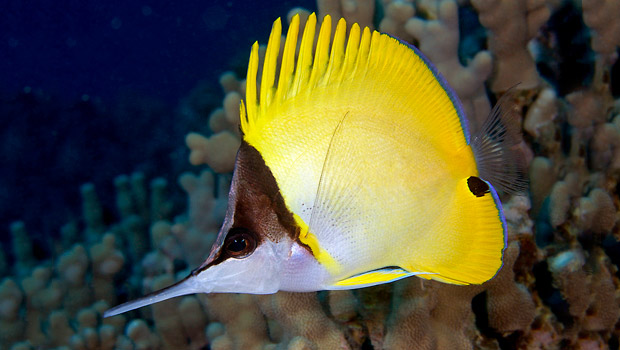Longnose Butterflyfish

The longnose butterflyfish, Forcipiger longirostris, or lau-wiliwili-nukunuku‘oi‘oi in Hawaiian, is named in three languages for its distinctive elongated jaw. The descriptive Hawaiian name also relates the similarities between the color and movements of the fish and the yellow dropping leaves of the wiliwili tree; as the name translates “the leaf of the wiliwili tree with a sharp snout.”
There are two species of Hawaiian butterflyfishes commonly known as longnose butterflyfish. The longer longnose butterflyfish (F. longirostris) has a jaw approximately one third longer than its shorter long-nosed relative, the forceps butterflyfish (F. flavissimus). Both species probe coral branches and reef crevices for small invertebrate prey, but details of their mouths and teeth indicate different feeding methods. The longnose butterflyfish takes its small prey, largely crustaceans, whole. The forceps butterflyfish, in contrast, tears off pieces of larger prey, like the tentacles of worms and tube feet of sea urchins.
The longnose butterflyfish has an Indo-Pacific distribution, but in Hawai‘i is largely limited to the southern end of the Hawaiian Island chain, and is seen more commonly around the Big Island or Maui. The forceps butterflyfish is found throughout the Hawaiian Chain, as well as elsewhere in the Pacific. The habitat of the longnose butterflyfish is in the deeper waters on the outer size of the reef, while the forceps butterflyfish is found primarily at shallower depths.
On the Kona coast of the Big Island, snorkelers and divers may observe a dark color morph of the longnose butterflyfish. The all-over black or brown coloration may not be permanent; the fish can apparently gradually change from the normal yellow color to its dark morph, and possibly back again. This has complicated attempts to exhibit the dark morph, because once in captivity they change to the normal yellow color scheme. The function of the dark morph is unknown. Some researchers suggest that the black morph might be better camouflaged around the dark basalt rocks of the Big Island’s coasts, but there has been no experimental evidence to support this hypothesis.
The longnose butterflyfish also bears the distinction of being the first Hawaiian marine organism to be collected and named by European scientists. It was the first fish described from the Hawaiian Islands after it was collected on Capt. James Cook’s third voyage in the “Resolution” (1776-1780). The Waikīkī Aquarium adopted the longnose butterflyfish as its logo, since it represents a meeting and common interest in the marine environment by both Hawaiian and European naturalists.
Quick Facts
Hawaiian name
lau-wiliwili-nukunuku‘oi‘oi
Scientific name
Forcipiger longirostris
Distribution
Indo-Pacific, including Hawai‘i
Size
to 8 inches (20 cm)
Diet
small reef crustaceans and invertebrates
Support the Aquarium
Contact Us
Honolulu, HI 96815
(808) 923-9741
Search
- Already a Volunteer?
- Click Here To Sign In


 Donate
Donate
